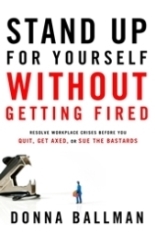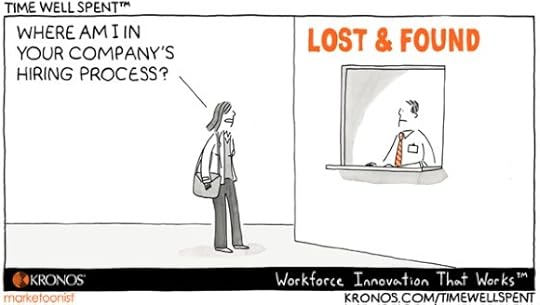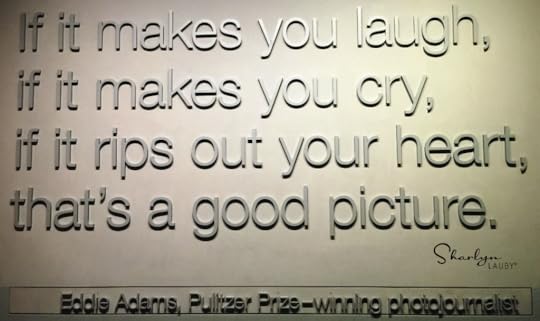Sharlyn J. Lauby's Blog, page 141
March 7, 2017
Reduce Turnover: Develop an Employee Experience Strategy – #WorkInspired
(Editor’s Note: Today’s post is brought to you by our friends at Kronos , a leading provider of workforce management and human capital management cloud solutions. Kronos was named one of the by Fortune Magazine in conjunction with consultancy Great Place to Work. Congrats to them! Enjoy the post.)
I know the phrase is well-worn, but the reality is that “the war for talent” is on. Forty percent of employers say they’re struggling to find qualified candidates, according to ManpowerGroup’s most recent Talent Shortage Survey. And while there’s talk about artificial intelligence (AI) helping organizations with recruiting processes, let’s face it, people want to be hired by people.
So, what really helps organizations attract and retain the best talent is having an exceptional candidate and employee experience. At Kronos, they call this WorkInspired. Chief People Officer David Almeda calls it a mutual promise between employees and the company. “Kronites bring their passion, ideas, talent, and customer-first mentality to work every day. In return, the company is committed to providing an engaging, transparent, collaborative, and high-trust employee experience. Being a great place to work is quite literally one of a small number of high-priority imperatives that are communicated to all employees each year as part of the company’s overall business strategy. In other words, being a great place to work is every bit as important as our traditional business priorities as a global software provider, such as application development and migrating customers to the cloud.”
We all know that people are candidates before employees, so I asked Almeda how Kronos brings WorkInspired to the hiring process. “We consider those early recruiting days with a prospective Kronite to be the beginning of an extended, very intentionally created employee experience. Our hiring process is meant to emulate the same WorkInspired experience and attributes that current employees enjoy.”
3 Ways to Improve the Candidate Experience
Make it easy for job seekers to find and apply for jobs. If the company can’t attract applicants, they can’t hire employees. Basic but true. Organizations need to be where candidates are and in today’s world, that’s on social media using a mobile device. Pew Research reports that as of January 2017, ninety-five percent of Americans own a cellphone of some kind and roughly half own tablet computers. Add to that seventy percent of Americans use social media, and it’s easy to see the importance of having a social and mobile recruiting strategy. If an individual isn’t ready to apply, organizations can use talent networks to stay engaged with candidates and keep them informed of what’s happening around the company.
Create a robust internship experience. One of the things that’s impressive about Kronos’ talent acquisition team is their commitment to go above and beyond for candidates and help them find the next best career move, with Kronos or elsewhere. Where you can really see that in action is their internship program. Kronos is committed to giving interns the best experience for their career, which includes participation in an “Intern Olympics” competition between Greater Boston technology companies. The event focuses on networking, leadership, and fun. It’s something the interns will hopefully remember for a long time, especially when they’re looking for career opportunities.
Give candidates a realistic job preview. At Kronos, candidates are exposed to as many potential colleagues as possible so they can better understand the company culture, the work environment, their would-be role, and performance expectations. Recruiters routinely share their expertise with candidates to demystify the job search process and help candidates present themselves in the most genuine and positive manner. Hiring managers are encouraged to make each candidate touchpoint special by demonstrating what WorkInspired means to them by sharing emails, articles, photos, and more to emphasize what it would be like to not only work at Kronos, but on that particular team and for that specific manager.
3 Ways to Improve the Employee Experience
Develop a meaningful feedback process for the employee experience. At Kronos, employees are asked to rate their managers twice a year. The ratings are focused on four key areas of manager effectiveness that they’ve determined makes up the DNA of their strongest people managers. Managers then share their results with their teams along with their plan for developing their areas of opportunities. Managers are also encouraged to share these results with candidates as part of the interviewing process – providing even more insight into what it would mean if they got the job. Additionally, managers are provided with target development goals while at the same time being held accountable to continuously improving their results.
Offer employees a competitive pay and benefits. Almeda acknowledges there never will be a one-size-fits-all benefits and perks program. “Kronites have a number of different interests and priorities driven by factors such as age, location, parental status and many, many others.” so we work hard to research what matters most to our people. We examine the data provided by our bi-annual global engagement surveys, run focus groups, and partner with third parties to develop a well-rounded package of benefits that is competitive, affordable, and appealing to Kronites. These programs fall into four core buckets: Care for Each Other; Care for Our Customers; Care for Our Families; and Care for Our Communities. The benefits are meant to maximize work-life for employees, with a stress on the fact that our families are the number one priority – not work.”
Create a productive office environment. If you’re not aware, Kronos is in the process of relocating their headquarters from Chelmsford, Massachusetts to the nearby city of Lowell. While moving more than 1,400 employees is a challenge, Almeda said Kronos used it as an opportunity for employee involvement. “Our very first action was to assemble a core team of advocates to work alongside our real estate, facilities, and procurement departments to build a new facility befitting our culture and the company we’ve become. The advocates’ responsibility is to act as a conduit between the Kronos design team and their individual departments: providing information and office updates downstream to their colleagues while bringing new ideas and feedback upstream to the core design team. We are also leveraging our internal collaboration platform, Chatter, to post move updates for Kronites, share plans and photos, and run polls to get a feel for what employees want to see in their new space or gather data about a specific design decision.”
Everyone Deserves a Great Manager
Whether it’s candidates or employees, recruiting and retaining the best talent takes great management. Almeda said Kronos is committed to developing Kronites. “We believe that everyone deserves a great manager. But being a great manager is not easy. It takes work. It takes coaching. It takes guidance. Above all, it takes courage. To maintain our success as a company, we know that we must invest in what we call manager effectiveness. A key part of evaluating the effectiveness of our 750-plus people managers around the world is how closely connected their direct reports feel to our overall corporate strategy and, more importantly, can see clearly how they directly contribute to our success.”
Organizations that want the best talent need to bring their recruiting process full circle. Create a candidate and employee experience that’s welcoming and inclusive. Then, inspire employees to drive the innovative ideas that moves the business forward. Ultimately, employees will share their stories. That’s what creating a best place to work is all about.
The post Reduce Turnover: Develop an Employee Experience Strategy – #WorkInspired appeared first on hr bartender.






March 5, 2017
How to Confront a Trash Talking Manager – Ask #HR Bartender
With unemployment decreasing and the challenges finding qualified candidates increasing, it’s sometimes amazing to me that employees have to deal with these manager situations. But they do.
I have a question and am hoping you can provide some advice. I overheard my supervisor speaking ill (very ill) of me and other team members. She also took complete credit of a situation that I handled with letting an employee, where I coached them on ways to improve their work.
This is the second time she’s spoken ill of me. The first time, she vented to our department director that I wasn’t doing a certain assignment. If she had come to me, she would have learned that I was completing my work, just not the way she does it. So, how should I handle this type of situation?
No one wants to find out that their boss is talking trash about them behind their back. I believe employees want to hear directly from their boss when they are not meeting expectations, even if the conversation is uncomfortable. Employees want the chance to fix the situation. Same is true for personality conflicts. If employees are in conflict, then managers should confront the situation and try to come to some resolution.
In this particular situation, we don’t know the specifics of what was said and how it was said. We don’t know the supervisor’s intent. We also don’t know the consequences of the supervisor’s actions. We’ve answered similar situations on HR Bartender before:
Documenting Conversations with Your Boss
How to Tell If Your Boss is a Bully or Just Tough
The other thing we don’t know about this situation is whether the reader discussed the matter with human resources. We’ve covered a couple of situations here on the blog where HR was brought into the situation, but it didn’t appear to help:
What to do When HR Doesn’t Listen
HR Failed to Investigate an Incident
I did ask our friend Mark Neuberger, an employment attorney with the firm of Foley & Lardner, if employees have legal recourse when a manager is trash talking about them. Here’s what he said:
“There is no law that says you have to be nice to employees, at least not yet. However, if the employee were the member of a legally protected group (race/sex/age/etc.) it would be easy for them to make a prima facie claim of discrimination. This would be especially true if they were the only victim of Mr. or Ms. Potty Mouth’s trash talk. Here is the problem – the employer could theoretically defend such a claim by proving the trash talk wasn’t because the employee was a protected group member but rather, for some other reason. But how will they do that? By proving the supervisor talk trash about other employees who are not in a protected category? That there was a business justification for talking about them like that? Those are horrible excuses and as someone who only defends employers in employment litigation, is not something that I would want argue as a defense to a jury.
Also, the victim could file a defamation law suit against Potty Mouth. To succeed in a defamation suit, the employee would have to prove 1) Potty Mouth made a false and defamatory statement concerning the plaintiff, 2) Plaintiff must prove that Potty Mouth communicated the false statement to others, and 3) The employee has been financially damaged.
A separate defamation lawsuit is not really advisable for a lot of reasons not the least of which it would be very hard to prove actual financial damages short of the victim losing their job. However, this would be the type of claim a good plaintiff’s side attorney would strap on to a lawsuit raising the type of discrimination claim discussed above. Plus, in a defamation suit they could sue Potty Mouth individually, which would really get their attention.
The bottom line is a manager shouldn’t be verbally abusive to employees even if it’s behind their back, and companies shouldn’t tolerate trash talking supervisors.” My thanks to Mark for sharing his experience. And, hopefully, we can all agree that his last sentence about “a manager shouldn’t be doing this and companies shouldn’t tolerate it” is the real takeaway.
Image captured by Sharlyn Lauby after speaking at the Flora Icelandic HR Management Conference in Reykjavik, Iceland
The post How to Confront a Trash Talking Manager – Ask #HR Bartender appeared first on hr bartender.






March 3, 2017
No News Is Good News Isn’t a Hiring Strategy – Friday Distraction
One of the most popular and frequently asked questions on HR Bartender deals with following up after job interviews. Here are some of the posts I’ve written in the past on the topic.
How to follow-up after a job interview
The company promised a second interview
Does providing references mean you’ve got the job?
That’s why today’s Time Well Spent from our friends at Kronos is both funny and unsettling. Candidates shouldn’t have to visit the ‘lost and found department’ to find out the status of their application.
More than ever, organizations today need to be focused on the candidate experience. Leaving a candidate confused about their status doesn’t send a warm fuzzy about the organization and its culture. If a company doesn’t take the time to tell candidates the status of their application, what other things does the company not tell current and future employees?
I remember years ago getting thank you notes from candidates after sending TBNT (thanks but no thanks) letters. Of course, they were disappointed that they didn’t get the job. But they were appreciative of the reply. They knew where they stood. The candidate could explore other opportunities. No news about a job doesn’t translate into good news. It’s aggravating and unnerving to candidates.
Organizations need to regularly communicate with candidates about their status in the hiring process. If that process is behind schedule – that’s okay – just let the candidate know. The good news is that technology solutions can help companies send out regular messaging to candidates. It’s both unrealistic and unfair to think candidates know by osmosis where they are in the hiring process.
The post No News Is Good News Isn’t a Hiring Strategy – Friday Distraction appeared first on hr bartender.






March 2, 2017
13 Tips for #SHRM17 Conference Attendees
For those of us in the human resources profession, the SHRM Annual Conference is approaching. This year’s event will be held June 17-21, 2017 in New Orleans. I’m really looking forward to the event. It’s an opportunity for me to see fellow bloggers that I interact with on Facebook and people that I worked with as a SHRM volunteer.
If you’ve never been to a SHRM Annual Conference before or it’s been a few years, let me tell you – it’s a big conference. We’re talking tens of thousands of people. Don’t let that scare you. It also means the conference offers something for everyone…if you prepare yourself properly. So, here’s my list of tips for people who are planning to go to the event:
Download the conference app. If you’re looking for copies of handouts and special announcements, it will all be in the app. You could wait and do it onsite. There will be WiFi during the conference, but it’s not like your WiFi at the office or home. So, download the app before you leave.
Plan your schedule but save some time for impromptu meetings. There’s a delicate balance between sticking to a schedule and taking advantage of last minute opportunities. If you’re a scheduling freak like me, I block off free time to use for last minute coffee meetings (or sneaking off to Café du Monde!)
Some of the best sessions are the early bird ones! I know, it’s New Orleans and the trip wouldn’t be complete without an evening on Bourbon Street – enjoy the parties. But I can tell you from experience, some of the best sessions are early in the morning. I know I’ll be grabbing a dirty chai to make the “Creating a Coaching Culture” session at 7a on Tuesday, June 20.
Don’t miss the legislative update! Mike Aitken, SHRM’s vice president of government affairs will be presenting a session on “The Trump Administration and the 115th Congress: The Washington Outlook for HR Public Policy” on Sunday, June 18 at 12:30p (right before the opening general session.) This is a session you won’t want to miss!
Download the SHRM Certification app before you leave. If you are a certified professional and have an iPhone/iPad, make life easy on yourself and download the SHRM Certification mobile app. You can track recertification points as you earn them.
Drink plenty of water. I know, everyone says this but it’s true. Personally, I think the most popular booths in the expo hall this year will be the ones giving away Yeti Ramblers or Swell water bottles. (Hint, hint to exhibitors looking for fabulous swag ideas.)
Use the bookstore as a central meeting location. Every time I’m at a conference, there’s always at least one moment where someone says, “Where should we meet?” The answer? Right in front of the SHRM Store. Works every time. And, while you’re waiting, you can check out the excellent books and resources they have available.
Follow the Twitter stream – #SHRM17. I know that not everyone is keen on Twitter but this is one of the things Twitter does well. Dust off your Twitter account before you leave and save the hashtag. It’s a way to follow the action. You might get some ideas about a session to attend, a book to purchase, or someplace fun to eat.
Check out at least one session on the Smart Stage. SHRM has their own version of TEDtalks – it’s called the Smart Stage. The sessions are short (less than 20 minutes) and take on a more conversational tone. I’m hoping to stop by Jonathan Segal’s session on “Social Recruiting and ‘Thong Man’” Tuesday, June 20 at 1:30p.
Pay it forward. We don’t know the plan for the Tuesday night party yet. Whoever it is, some people will love it (and others not so much). If you’re not going to use your Tuesday night ticket, give it to someone who will use it. At some point, you will want someone to do that for you.
EXPO! I simply cannot say enough how important it is to visit the vendors in the expo hall. These companies are the reason that SHRM can get awesome speakers and keep registration prices low. Exhibitors and sponsors offset those costs. So, walk around the expo and see the latest HR products and services.
Bring a FedEx label to mail yourself stuff home. The expo hall is also the home to all kinds of conference swag. If you’re concerned about your luggage hitting the weight limit, just print off a FedEx shipping label and mail stuff home. If you don’t use it, fine. At least you have a plan.
Join the SHRM Foundation Step Challenge. This is a relatively new addition to the SHRM conference activities and one I really enjoy. It gives me a steps challenge and I’m giving back to my profession at the same time. Stop by the SHRM Foundation booth (#1941) for details!
Oh, and one last thing…back again this year is the Social Solutions for HR preconference workshop. The session will be held on Sunday, June 18 from 8a to 12n and it’s focused on sharing social media strategies that will help HR achieve their business goals. I’m delighted to be one of the speakers and I hope you can join us.
As you can see, SHRM’s Annual Conference and Expo offers a lot of education, networking, and fun for professionals looking to stay current with what’s happening in the profession. See you in NOLA!
Image captured by Sharlyn Lauby wondering down Bourbon Street in New Orleans, LA
The post 13 Tips for #SHRM17 Conference Attendees appeared first on hr bartender.






February 28, 2017
A Bad Idea (When Perfectly Executed) Is Still a Bad Idea
Execution is essential to the success of any idea or project. It’s the most visible part of launching a new program. Do it well and you’re a hero. Do it badly and there will be questions. Frankly, the questions would be well deserved. It makes no sense to spend weeks or months doing an analysis, pitching the idea to senior management, asking for resources, etc. only to fail during the rollout.
I’ve written before on this blog about the importance of execution. There are books dedicated to the topic like Larry Bossidy and Ram Charan’s “Execution: The Discipline of Getting Things Done”. In fact, I just learned of a software platform called GlitchPath that will help organizations do a project “premortem” to reduce the chance of failure.
But here’s the thing: the idea or process or project that you are implementing has to be a good one. A bad idea, even if you implement it flawlessly, is still a bad idea. And a bad idea implemented poorly, well…that’s a disaster. All the good implementation in the world will not turn a bad idea into a good one.
The goal is always to come up with good ideas and implement them well. But that’s not as easy as it looks. At least if you have a good idea and it’s not implemented well, there might be an opportunity to recover. Take Listerine for example. In the book “Freakonomics”, the authors say that Listerine was originally invented as a surgical antiseptic. It was also sold as a floor cleaner. But it didn’t reach success until it was pitched as a cure for “chronic halitosis.” Listerine was a good idea that wasn’t executed well (a couple of times) but eventually found success.
While I will admit that sometimes you can’t tell if an idea is good or not until it goes to market, there are a few things you can do to get some initial feedback about the idea or plan. It can help the organization decide if they want to make the investment into development. Here are four questions to get you started:
Does it solve a problem? If so, what is the problem?
Is it easy to explain – without charts/graphs/PowerPoint?
How many other companies are offering the same thing?
Will people spend money for it? Enough to support the idea?
Once organizations have decided to start turning an idea into reality, they must spend dedicated time discussing execution. This doesn’t need to be a lengthy process. It does need to be thorough.
WHEN will the process start? Are there milestones that must be accomplished?
WHO will be responsible?
WHERE will implementation take place?
HOW will the idea be implemented?
WHAT should we communicate? To whom? When?
Sometimes thinking about execution can expose vulnerabilities in the project. That’s a good thing. I understand that some organizations today aren’t looking to launch products when they are perfect. They just need to be good enough. But the organization needs to be conscious that this is what they are doing. They are still striving to introduce a good product in the best way possible.
The competitive nature of business tends to create a race to be first to market. Organizations must decide if first is where they want to be. It is possible that perfectly executed second to market is a more desirable position.
Image captured by Sharlyn Lauby after speaking at the 2016 MBTI Users Conference in San Francisco, CA
The post A Bad Idea (When Perfectly Executed) Is Still a Bad Idea appeared first on hr bartender.






February 26, 2017
10 Recruiting Tips for First Time Managers
One of the things that often happens when you become a supervisor or manager is that you’re invited to participate in the recruiting process. It could be because you’re now responsible for a team of employees. Or another manager will ask you to participate because you will work closely with one of their employees.
Regardless of the reason, there are a few things that new managers need to understand about their role in hiring.
Tell HR when an employee resigns. And tell them right away. According to the Society for Human Resource Management (SHRM), the average time to fill a position is 42 days. The typical notice period is two weeks. If you tell HR about a resignation when it happens, then you’re only potentially without an employee for 28 days (assuming you get a two week notice). If you tell HR on the employee’s last day, that increases to 42 days. Allow HR to help you – tell them as soon as you know.
Review the job description. This is the perfect opportunity to make sure that what’s written on paper about the job is what the employee actually does. Responsibilities change regularly – and that’s okay. Just make sure the job description reflects what the employee is going to do. And make any necessary updates.
Discuss contingent staffing. In #1, we talked about how long it takes to fill a job. If you already know you can’t live a month without an employee, talk with your boss and HR about what can be done. Maybe overtime can be authorized or a freelancer can be brought in to help.
Hiring managers are allowed to source candidates. When job openings occur, remind the rest of the team that the employee referral program exists (you do have one, right?). Encourage them to tell the opening to their friends. Send out info about the opening to your social media network. Sit down with HR and tell them where you have connections. Work with them to source applicant flow.
Don’t assume you know how to interview. I know on the surface that interviewing sounds very easy. But it’s not. There are questions that are illegal to ask like “How old are you?” and in some states asking “How much money do you make?” There’s an art to interviewing. Ask HR if there’s an opportunity to attend interview training.
Take good interview notes. Don’t try to remember everything! If you interview 3-4 people, it will be tough to distinguish between candidates. Find out how to take good (and legal) interview notes. Tell candidates during the interview that you will be taking notes.
Collaborate! I’m a big fan of collaborative hiring. Identify a couple of people who the employee will work with regularly and get them involved in the recruiting process. It helps to create buy-in and it allows a new hire to know more than one person when they start. Every organization has unwritten rules and new hires will want to find answers – but maybe not from their boss.
Keep the candidate informed. At the end of an interview, tell the candidate how the recruiting process works, the timetable to make a decision, and who they should contact once they leave. But first, make sure you and HR are on the same page about this information. Even if the candidate doesn’t specifically ask, let them know anyway.
Always send a TBNT (Thanks but No Thanks). The people who interview with your company have the opportunity to also buy your product / service. You don’t want to lose a candidate and customer at the same time. If a candidate isn’t being considered any longer, let them know. They will respect you and the company. Coordinate response letters with human resources.
Look for talent, even when there’s not an opening. In #4, we talked about managers helping to source candidates. That doesn’t have to take place only when there’s an opening. Managers should always be looking for talent. For example, I’ve never worked with a sales director that wasn’t always on the search for good sales talent. And when they found them, they presented the candidate to the company. Didn’t matter if we had an open requisition or not.
When it comes to recruiting, everyone has the same goal – find the best talent, as quickly as possible, using the most cost-effective means. It’s not just “an HR thing” because managers will ultimately work with the employee. So managers should join the recruiting process. It’s a win for everyone involved.
Image captured by Sharlyn Lauby at the 34th Street Graffiti Wall in Gainesville, FL
The post 10 Recruiting Tips for First Time Managers appeared first on hr bartender.






February 24, 2017
Quick Shots for #HR and #Business Pros – Curation Edition
There’s been a lot of conversation lately about what is being termed “fake news”. While the discussion about fake news has been related to politics, it occurred to me that this could easily happen in the business world. ERE had a blog post about it – “Fake News Afflicts the Workplace Too.”
Sue Meisinger, former CEO of SHRM, also talked about “HR and Fake News” in her latest Human Resource Executive Online column.
NPR had a nice read recently on “Fake or Real? How to Self-Check the News and Get the Facts.” What I liked about this article was that the author wasn’t trying to tell you ‘this source is fake news’ and ‘this source isn’t.’ They just provided a list of steps you could use to figure it out for yourself. Step #1 – Pay attention to the domain and URL.
Candidates and employees use the internet for information. There’s no way around it. Organizations should make sure that employees are able to identify good, trustworthy sources. I call it curation. And I believe it’s a business competency that needs to be developed.
In fact, some organizations are implementing programs to help employees refine their curation skills. A couple of years ago, I had the opportunity to hear how Fujitsu Labs was using content curation in organizational learning. Their 3-step approach for learning curation can be used in many organizations.
1) Employees search the topics they wish to explore, identify relevant sources, and select content.
2) After analyzing the content, they synthesize it by adding their point of view or context.
3) Then, employees share their curated materials and comment on others curated materials.
Training Magazine also has a feature story on “The Art of Content Curation.” This article focuses on the connection between subject matter experts (SMEs) and content curation. I believe in today’s business world everyone is an expert at something, so making sure that SMEs are perceived as trustworthy sources of news and information is important to their credibility.
I saw an article that said the world’s internet traffic surpassed one zettabyte last year. I cannot even fathom how big that is…but it’s big. Huge. It goes without saying that there will be some less trustworthy information. And unfortunately, some flat-out made up stuff. We must be responsible internet users and, before we share, make sure what we’re sharing is accurate.
Image captured by Sharlyn Lauby at the Newseum in Washington, DC
The post Quick Shots for #HR and #Business Pros – Curation Edition appeared first on hr bartender.






February 23, 2017
All Employee Medical Information Isn’t Protected by HIPAA
Regardless of your political views, I think it’s safe to say that the U.S. is discussing health care. I’m not here to tell anyone how they should feel about the Affordable Care Act (ACA). However, with this discussion comes a lot of disclosures about medical information. As in, “I’m an employee who has ABC condition and this is what I think about ….” or “My spouse/child/etc. has XYZ condition and therefore, we need to do…”
Meanwhile, I received the Foley & Lardner LLP newsletter and it included an article from our friend Mark Neuberger on the Health Insurance Portability and Accountability Act (HIPAA). I thought the information was timely, so asked him if he would share his knowledge with us.
I know I don’t have to remind you, but just in case, please remember that Mark has a regular full-time job being a lawyer and he’s doing this to give back to the profession. His comments should not be construed as legal advice or as pertaining to any specific factual situations. If you have detailed questions, you should address them directly with your friendly neighborhood labor attorney.
Mark, give us a brief description of HIPAA.
[Neuberger] The Health Insurance Portability and Accountability Act of 1996 or as it is more commonly known, HIPAA is a federal law that was enacted to ensure protection of individuals’ protected health information (PHI). The Standards for Privacy of Individually Identifiable Health Information (aka the ‘Privacy Rule’) issued by the Department of Health and Human Services (HHS) established detailed national standards for the protection of PHI.
In general, HIPAA protects individuals from the unauthorized use or disclosure of any PHI. Most employers, knowing they almost always have some health-related information on their employees gathered from things such as workers’ compensation claims, fringe benefit administration, and administration of leave and absenteeism policies should be rightfully concerned about their compliance with HIPAA’s Privacy Rule.
Why should HR professionals be focused on HIPAA’s Privacy Rule?
 [Neuberger] I’ve been fielding lots of calls from HR managers lately who always start with the proposition that any medical information they have about their employees is protected by the HIPAA Privacy Rule. In most instances, this is not the case.
[Neuberger] I’ve been fielding lots of calls from HR managers lately who always start with the proposition that any medical information they have about their employees is protected by the HIPAA Privacy Rule. In most instances, this is not the case.
HR professionals should develop policies and procedures to secure what employees believe are their confidential medical records. Train your management to know what they can ask and what they would be better off not asking. It may not be PHI but that doesn’t mean you want TMI (Too Much Information). TMI is information you don’t really need to make appropriate management decisions. The fact you have TMI can be used by an employee to make out the elements of a discrimination claim.
TMI negates the ‘Huh, I didn’t know defense.’ The best way to defend a claim of discrimination is by being able to say ‘How could I have discriminated against the employee when I had no idea they (had cancer, are taking lithium, seeing a psychiatrist, etc.)’. If you have TMI and know these things because you made inquiries into things you maybe should not have, you can’t invoke the ‘Huh, I didn’t know defense.’
Does the HIPAA Privacy Rule apply to all employers?
[Neuberger] The HIPAA Privacy Rule only applies to ‘Covered Entities’ which are defined by the regulations as:
A health plan;
A health care clearinghouse and;
A health care provider who transmits any health information in electronic form in connection with a transaction covered by this subchapter, and their ‘Business Associates,’ which are vendors that provide services for or on behalf of Covered Entities involving PHI.
Under this definition, Covered Entities are health plans, health care clearinghouses, and health care providers. Thus, the Privacy Rule WILL apply to employers if they somehow operate as a health plan, a health care clearing house, or a health care provider. Most other employers will not be ‘Covered Entities.’ Note that many employers function as the plan sponsor of a group health plan, but that does not make the employer itself a ‘Covered Entity’ under HIPAA.
You recently helped us with a reader question about “ Keeping Employee Records Secure ”. Where is PHI typically found?
[Neuberger] Most of the information contained in an employer’s personnel files and records is not PHI. The regulations state ‘Protected health information excludes individually identifiable health information…in employment records held by a covered entity in its role as an employer.’ Thus, even the information held in employment records by healthcare institutions is generally not governed by HIPAA.
The fact that the information you maintain in employment records about your employees is not regulated by HIPAA should not be the basis to ignore legitimate privacy concerns of your employees. You may be subject to various state privacy laws which afford different and additional protections to your employees than does HIPAA. Additionally, employers may have to deal with a knowledge gap in that many employees firmly but wrongly believe they are entitled HIPAA protection over their workplace medical records.
HR professionals sometimes hear about medical information when discussing workers’ compensation claims. Does this factor into the Privacy Rule?
[Neuberger] The Privacy Rule gives employers a break. The rule recognizes that employers, their workers’ compensation insurers and claims administrators have a legitimate need to access detailed medical records in order to efficiently administer the workers’ compensation system. In many cases, the Privacy Rule allows covered entities, those providing the medical treatment to your injured employees, to disclose treatment information without violating HIPAA.
Last question. What are 1-2 things HR professionals can do to stay on top of HIPAA’s Privacy Rule?
[Neuberger] This is a complicated and constantly evolving area of the law so employers should get smart and stay smart as to all the applicable laws. Don’t forget the Americans with Disabilities Act (ADA) and the Genetic Information Nondiscrimination Act (GINA). These laws have plenty to say about employee medical records.
Title I of the ADA provides that information obtained by an employer regarding the medical condition or history of an applicant or employee must be collected on separate forms, kept in separate medical files, and be treated as a ‘confidential medical record.’ 29 C.F.R. §1630.14(b)(1).
Similarly, if an employer has genetic information obtained under one of GINA’s limited exceptions, they must also keep this information separate from personnel files and treat it as a confidential medical record. This information may be maintained in the same file as medical information obtained under the ADA. 29 C.F.R. §1635.9.
Finally, when asking your employees to provide any medical information be it to administer leave, fringe benefits, or workers’ compensation, get a properly drafted release and consent from the employee.
My thanks to Mark for sharing his knowledge with us. If you want to stay on top of HIPAA and other legal issues, sign up for Foley & Lardner’s electronic newsletter or follow one of their blogs.
Whenever there’s a new administration, there are new laws. Sometimes we can get so focused on what might happen that we lose sight of the laws currently in place – complicated laws like HIPAA. Reading a blog article or going to an association meeting can be a good reminder of the compliance actions we need to stay current.
Image captured by Sharlyn Lauby while wandering the Wynwood District in Miami, FL
The post All Employee Medical Information Isn’t Protected by HIPAA appeared first on hr bartender.






February 21, 2017
Employees Need to Learn Freelancing Skills
I read a Wall Street Journal (WSJ) article recently titled, “The End of Employees”. It’s a good read and you should check it out when you have a moment. The article talks about the growing number of companies that are using freelancers, contractors, etc.
Freelancing is more than a trend. It’s a business dynamic that deserves attention. There are lots of different terms for it – some call it a contingent workforce or the gig economy. The Bureau of Labor Statistics (BLS) defines a gig as “a single project or task for which a worker is hired, often through a digital marketplace, to work on demand.” Regardless of what you call it, there’s a lot of it going on.
According to the Freelancers Union (and yes, there is one), freelancing is a $1 trillion industry (that’s not a typo – trillion with a t). Freelancing represents 35 percent of the U.S. workforce. And probably one of the biggest things to know is that a growing number of individuals are choosing freelancing as a career (63 percent). We need to shed the stereotype that freelancing is this thing people do when they can’t find a job.
As the WSJ article mentions, organizations are benefitting from using contingent workers. They can tap into specialized talent when they need it. They can flex up or down their operations easily. This is the “borrow” component of a buy, build, and borrow recruiting strategy.
But there are a few things that I would add to the WSJ article. If you’re an organization looking to develop a contingent worker strategy, or an individual wanting to start freelancing, here are a few things to keep in mind:
Organizations that want to hire freelancers:
Put a process in place to source, select, and onboard freelancers. If you’re bringing on freelancers because they have specialized skills, then this isn’t a “lowest fee” hire. Do your homework and understand the market. Select a freelancer who will work well with the team. And give them the tools to be successful. If they will need to attend an internal training session, let them know that in advance.
Engage your freelancers. The goal of developing a contingent workforce is to have people who will drop everything and help you when you need it. The way to accomplish that goal is to keep them engaged with the organization. We’re not talking about dangling an occasional carrot. Engagement can be keeping them informed about what’s happening. Possibly inviting them to an internal gathering. Or sending them a thank you note for a job well done.
Individuals who want to freelance:
Learn the critical skills associated with freelancing. Being an employee and freelancing are two different things. They both have their advantages. But freelancing includes acquiring reliable technology, having a workspace to be productive, and budgeting for your own professional development. Freelancers must know how to price, sell, and service what they do.
Get comfortable with the unknown. Freelancing involves not getting a paycheck every week. There’s no such thing as paid health insurance. On the plus side, you also don’t have to ask anyone for a vacation day. Freelancers should be comfortable with working on their own, with little guidance at times. They must budget their time. And they need to be okay with occasionally not having a client.
The real success of the gig-economy isn’t how many people are using it. It’s how many people are using it successfully. Individuals need to learn the skills to be successful freelancers. And it could make some sense for organizations to teach employees how to become successful freelancers. Because if that’s the direction we’re heading, then organizations will want people to have those skills long before they need them.
Image captured by Sharlyn Lauby after attending the Great Place to Work Conference in Austin, TX
The post Employees Need to Learn Freelancing Skills appeared first on hr bartender.






February 19, 2017
What To Do If You’re Placed On Suspension – Ask #HR Bartender
I know. You’re reading the title of this post and probably saying to yourself, “What the –?!” That’s exactly what this HR Bartender reader is saying as well.
I would like to know if I have the right to contact my employer regarding the outcome of an investigation.
I was placed on suspension in November 2016. I don’t know why I was suspended and HR didn’t ask me any questions on the day I received my suspension. I haven’t heard anything. My manager said he doesn’t know what’s going on because the person in HR is on leave.
There’s a lot going on in this situation so it’s not possible to give a single response. However, there are a few things about suspensions that you might want to know. To offer some insights, I asked employment attorney Donna Ballman to help us out. She’s helped us before – one of my faves is the post “Can You Bring Your Mother to a Meeting With HR?”

Please remember that Donna does have a full-time job and her comments should not be construed as legal advice or as pertaining to any specific factual situations. If you have detailed questions, they should be addressed directly with your friendly neighborhood labor attorney.
Donna, in your experience, why are employees placed on suspension?
[Ballman] Holy cow! What a question. It could be just about anything. Sometimes it’s just because there is an investigation going on. It’s usually paid if that’s the case. The best example I can give is one we’ve seen in the news when a police officer is involved in a shooting, so they are placed on suspension pending investigation. An unpaid suspension could be because the company has concluded the employee did something wrong or for a host of other reasons.
Should an employee expect to be interviewed if they are placed on suspension? Why or why not?
 [Ballman] It would be normal for a company to interview an employee either before, during or right after a suspension. Before would be the norm if the suspension is after an investigation for some kind of wrongdoing. Most companies would interview the employee before coming to the conclusion they did something wrong (but that’s not always the case).
[Ballman] It would be normal for a company to interview an employee either before, during or right after a suspension. Before would be the norm if the suspension is after an investigation for some kind of wrongdoing. Most companies would interview the employee before coming to the conclusion they did something wrong (but that’s not always the case).
If the suspension is pending an investigation of some sort, then the interview could be before, during or after the suspension. The company will usually want to get the employee’s input on the investigation. They’ll do it before if they need the employee’s information and witness names before they can complete the investigation. They’ll do it during or after if they want to find out what any witnesses and evidence showed before they talk to the employee.
It’s important to know, though, that there is no law in any state I’m aware of that requires the company to interview the employee either pre- or post- discipline.
It only seems logical that if an employee is placed on suspension, there needs to be follow-up. How should an employee contact the company (if they think the process is taking unusually long)?
[Ballman] I’ve seen employees left in limbo for months, and some never get an answer because unscrupulous employers want to claim the employee quit so they leave them hanging indefinitely. I’d definitely follow up at least once a week (unless told otherwise), in writing via email with a read receipt and delivery receipt, something to the effect of:
“I am following up on my suspension which commenced on [date]. I would like to return to work as soon as possible. Please let me know when I may return. I am ready, willing, and able to provide any additional information you need.”
While an employee is on suspension, does the manager have a role in communicating with the employee?
[Ballman] Either HR or the manager should be communicating with the employee. Sometimes the left hand doesn’t know what the right hand is doing though. I would suggest that the employee clarify with the company the protocol as to who they should be communicating with.
There are some details we don’t know about this organization in terms of size and how many HR representatives they have on staff. It is possible that someone in HR went out on leave or had a serious accident. What can organizations do to keep HR processes moving when HR is unavailable?
[Ballman] If it’s a suspension with pay, you’d think the company would be right on top of that so they aren’t paying someone to stay home. If it’s without pay, they may not care. Normally, it is wise for a company to have a person designated to handle HR issues in the absence of the HR person. If they have a policy saying employees should report, say, discrimination or the need for Family and Medical Leave (FMLA) to HR, then having nobody there or telling nobody who is covering could cause serious liability problems.
Remember, even tiny companies could be subject to state laws and local ordinances about discrimination and other issues. Here in Florida, several counties have discrimination ordinances covering employers with 5 or more employees. I know it’s tempting for a small company to be a little loosey-goosey in its procedures, but having someone designated to deal with HR issues at all times is just basic. I would consider this a bare minimum requirement if the company wants to prevent employee lawsuits.
 My thanks to Donna for sharing her knowledge with us on this difficult topic. Please be sure to check out her blog on employee-side employment law issues, Screw You Guys, I’m Going Home. It’s been named one of the American Bar Association’s 100 best legal blogs for the past five years. And she’s the author of the award-winning book “Stand Up for Yourself Without Getting Fired: Resolve Workplace Crises Before You Quit, Get Axed or Sue the Bastards.”
My thanks to Donna for sharing her knowledge with us on this difficult topic. Please be sure to check out her blog on employee-side employment law issues, Screw You Guys, I’m Going Home. It’s been named one of the American Bar Association’s 100 best legal blogs for the past five years. And she’s the author of the award-winning book “Stand Up for Yourself Without Getting Fired: Resolve Workplace Crises Before You Quit, Get Axed or Sue the Bastards.”
This reader note is a prime example of the need for good organizational communication. Companies need to communicate expectations. Managers and employees need to regularly communicate about performance. HR needs to communicate policies and procedures. Follow-up communications need to happen.
Image captured by Sharlyn Lauby after speaking at the 2016 SHRM Annual Conference in Washington, DC
The post What To Do If You’re Placed On Suspension – Ask #HR Bartender appeared first on hr bartender.






Sharlyn J. Lauby's Blog
- Sharlyn J. Lauby's profile
- 10 followers
















